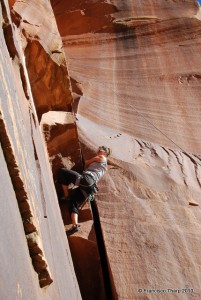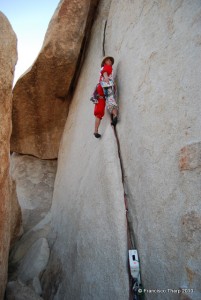
Julia Morton, Warrior Princess. Indian Creek, UT
I was cross country skiing out of Crested Butte the other day when my 30-year-old 3-pin binding pulled out of my 30-year-old Nordic skis. As I fumbled with frozen hands to free my boot from the binding, a comforting thought occurred to me: It’s almost climbing season! And the joy of that helped as I post-hole glided home.
The next day, as if on cue, I got an invite to Red Rock, Nevada, land of sport cragging and 10-pitch moderates. “Rock climbing? March? Oh, yeah, Climbing sounds great,” I said loud, slow and obvious, hoping my Nordic skis – which were in timeout in the corner – would overhear. Now, after the initial jubilation has worn off, I’m bracing for a super sore reentry. The closest thing to training I’ve done this winter is pull ups on the rafters of the bus-stop awning to keep warm while waiting for the free town bus. Crested Butte doesn’t have a climbing gym, I’m not much of an ice climber, and my fattening tele thighs are going to be like kicking, wiggling anchors in the air.
But there’s hope: The Rock Warrior’s Way, a book I try to read annually at the beginning of every climbing season. While I can’t pump the forearms, I can still train the brain and keep my spirit ready for the sharp end by revisiting this metaphysical equivalent of a hangboard. In short, The Rock Warrior’s Way revolutionized not only how I climb, but also how climbing fits into my life. Even shorter, The Rock Warrior’s Way made me a happier, healthier human being. I highly recommend it to climbers of any sort.
For millennia, nearly all cultures have trained and employed warriors: people who either kill or are killed; people who brush death every day at work; people for whom a split second delay is the end. “Essentially, a warrior is an impeccable hunter of personal power,” writes the book’s author, Arno Ilgner. “He gains power by taking forays into the unknown where he focuses his attention, grapples with chaos, and learns from the experience.” Turns out, the way warriors use their attention on even the simplest task can benefit anyone, not just those who get their fight on regularly. Thus, the idea of a Peaceful Warrior. The Rock Warrior’s Way integrates these multicultural philosophies, along with more contemporary Peaceful Warrior philosophy from the likes of Dan Millman (The Way of the Peaceful Warrior) and Carlos Castaneda (Journey to Ixtlan and many others). Ilgner then applies the ideas to the cliff face, where steep run-outs, difficult climbing, sustained exposure, dicey gear or any number of other factors can make us feel very much like we’re on a battle field, where life is amplified by the easy proximity of its counterpart.
The book focuses on identifying thoughts and action that drain our energy

Who said the Rock Warrior's Way is all serious? Matt Bynum, focusing his impeccable attention and feeling secure above a well-placed #6 Franzia box. But then again, how could you not send hard in a clown suit? Joshua Tree, CA
(like fear, wishful thinking, and destination attachment) and offers seven processes that, in contrast, help us become more powerful and capable. Those seven processes explore how we use our attention, how we breath, how we guide our internal dialogue, how we react to adverse and unexpected conditions, and more. They also cut to the very essence of why we climb: “Once in the chaos of risk, you focus on the journey not the destination,” Ilgner writes. “When you’re stressed you are tempted to rush through the stress. Yet, if you have prepared well, this stressful situation is exactly why you came here in the first place. It holds the rhyme and reason for your climbing.” Each process distills into a single action word: Observe, Center, Accept, Focus, Commit, Trust, and Attention.
I first read The Rock Warrior’s Way in the spring, about five years ago. At that point, my emotional state as a climber seemed to match my emotional state in general: I was beginning to lead trad, and was exhausted by fear after only a couple pitches. In non-climbing life I was experiencing the lowest emotional point yet (which I’d say is not all that low – I’m a pretty happy dude). I had just exited an ugly relationship that I had let sap all my energy. Fear, loneliness, doubt and depression had become regular companions. Ilgner pegged my love-hate relationship with climbing immediately: “If you’re using fear to motivate and energize you, you’re showing a symptom of a more significant problem which is probably affecting your entire ability to enjoy climbing and improve: being out of touch with your love of climbing.”
As early spring warmed into the Front Range climbing season, I picked the book up at The Mountain Shop, and I started climbing more. As I matched a practice of climbing and reading, the act of moving up rock became an exercise in spiritual well being. I began to not only enjoy my vertical time more, I felt like I was taking something important home from the crag every day. The most important find was an ability to surrender to joy and beauty amidst the challenge, pain and uncertainty of never ending growth both on the rock and off.
While I’ll still have a sore body in Red Rocks in a couple weeks, I hope to at least have a smiling face, a clear head, and a strong heart as I rack up, tie in and leave the comfortable deck behind.
Have any of you had experiences with The Rock Warrior’s Way? Let’s hear about it!
Other related and recommended reading: Dan Millman’s The Peaceful Warrior. Carlos Castaneda’s Don Juan series including The Teachings of Don Juan, The Teachings Continued, A Separate Reality, and Journey To Ixtlan.
Wise man say, "Rock Warrior is but shadow on wall of life."

